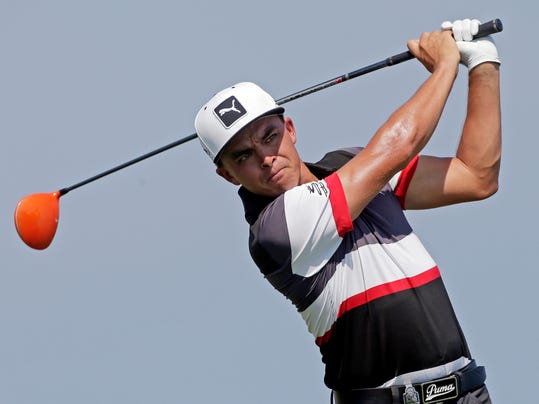Golf's Affinity For Youth At The Expense Of Achievement
/I get it: golf is not cool. Never really has been. Usually the winners of majors have a few wrinkles and look silly in a flat-brimmed hat. Like, OMG, ick.
 When winners of major golf tournaments are young and the new thing, they're understandably adored. In the cases of Rory McIlroy, Jordan Spieth and Jason Day's, they absolutely should be cause for excitement.
When winners of major golf tournaments are young and the new thing, they're understandably adored. In the cases of Rory McIlroy, Jordan Spieth and Jason Day's, they absolutely should be cause for excitement.
This doesn't make it right to ignore or whitewash history.
Doug Ferguson did the best job of celebrating the breakthrough year for several young players in 2015, most obviously Jordan Spieth. And Ferguson managed to NOT make the point of a generational shift at the expense of people who have built impressive careers. Ones that many of today's next all-time greats would love to have when they in their forties. Ferguson's best point about the short memories in golf was actually made by Rory McIlroy.
Woods had a revolving door of rivals for more than a decade. He was No. 1 even when the math said otherwise.
Now there is a chance for a lasting rivalry, or rivalries. There already is talk of a modern "Big Three," though it's still too early for that.
"We live in such a world that everything is so reactionary, and everything happens so quickly," McIlroy said at the start of the PGA. "A year ago after I won this tournament, it was the Rory era. And then Jordan wins the Masters and it's the Jordan era. Eras last about six months these days instead of 20 years."
Because of his recent play, the incredible playing legacy of Tiger Woods is now under threat given that he was winning handily not that long ago. But it's not just Tiger who is taking a hit because of his recent struggles: the way he beat players so handily (versus today's tightly-bunched leaderboards) has folks as venerated as Dan Jenkins and as not venerated as Shane Ryan suggested Tiger beat a bunch of "nobodies."
The eagerness to declare the new Big Three and to downplay the achievements of Woods is rooted in the desire to make golf appealing to a new generation of fan, one that finds the game about as appealing as previous 18-34 year old demographics. Not very interested.
There are obvious financial motives for hyping the young talent at the expense of those falling outside the coveted demo. Marketers want to reach 18-34 year old's, so we see hype for these youth saviors of the game threaten to spin out of control and undermine the very reasons to be excited about the latest Big Three. Also clouding judgements: Tiger's character and attitude toward media compared to the latest wave. Traces of old-fashioned entitlement and general ignorance of history could also be part of the equation.
The rush to anoint is dangerous and a little embarrassing when you consider Rory's point. Remember back in May when Rickie Fowler joined a mythical "big three" after winning The Players? Or when Jason Dufner and Keegan Bradley were the next greats after their 2011 and 2013 PGA Championship wins? Where are they now in the discussion?
The short attention span reaction would be less bothersome if there wasn't re-writing of history threatening to take place. We have a sport with tremendous history which, because of its slowness and cost, will always skew older no matter how hard people try. We can't allow Tiger's legacy and the great achievements of those prior to 2010 be tainted. Nor should we stand for the suggestion that no one prior to the current generation was capable of strength, athleticism or eye-opening skill.
On Sunday night after the PGA, Golf Channel's Live From gang addressed the overall sense that a course built for this new generation of player was already beginning to have a hard time asking interesting questions of players due to 380-yard drives. They insisted this was an exciting form of play thanks to great athleticism and club optimization. Pro-bifurcationist Brandel Chamblee, who respects and understands the game's history, even got caught up in the moment, insisting this was "the evolution of the athlete" and projected a sense that we were watching a vastly superior collection of golfers, the likes of which we'd never seen before. John Strege documented at GolfDigest.com.
“You go back to when they started measuring clubhead speed out here and it wasn’t that long ago, in 2007. In every single spot, they’re faster. They’re faster. They’re faster. The [equipment] limits were set along that time, so it is the athlete that is better. This is the only sport I know where when they light it up we all have a knee-jerk reaction to respond and say, ‘well, the equipment, the equipment.’ At some point you do have to celebrate the athlete. I don’t think anybody watches Usain Bolt break the tape and go, ‘it’s the shoes.’
“Yeah, I get it. They’ve got longer drivers, they’ve got bigger heads. But these guys don’t look anything like the previous generation, and they didn’t look anything like the previous generation to that. It is a beautiful landscape out here. They’re fit and they can flat swing it hard.”
Yes, they swing hard and don't look like any previous generation. They're taller, leaner, smarter, better scripted and just darn special. But don't tell us this makes them superior golfers historically or that previous generations with access to today's stuff would not be able to do similar things armed with the same arsenals of equipment and outside assistance.
There is no reason to downgrade the accomplishments of previous generations in the rush to anoint the latest the absolute greatest. Especially to feed an imaginary beast that is coveted demo.











